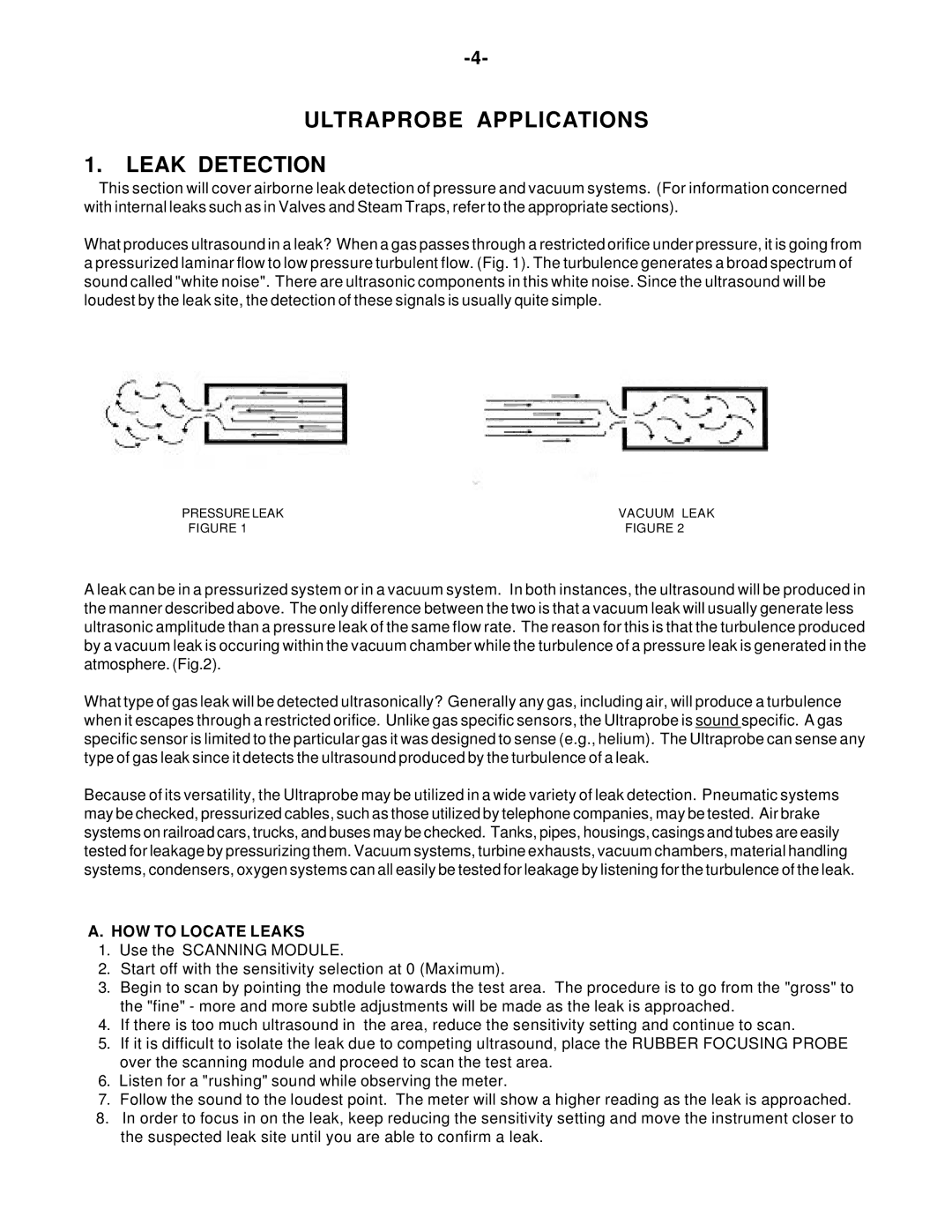
ULTRAPROBE APPLICATIONS
1.LEAK DETECTION
This section will cover airborne leak detection of pressure and vacuum systems. (For information concerned with internal leaks such as in Valves and Steam Traps, refer to the appropriate sections).
What produces ultrasound in a leak? When a gas passes through a restricted orifice under pressure, it is going from a pressurized laminar flow to low pressure turbulent flow. (Fig. 1). The turbulence generates a broad spectrum of sound called "white noise". There are ultrasonic components in this white noise. Since the ultrasound will be loudest by the leak site, the detection of these signals is usually quite simple.
PRESSURE LEAK | VACUUM LEAK |
FIGURE 1 | FIGURE 2 |
A leak can be in a pressurized system or in a vacuum system. In both instances, the ultrasound will be produced in the manner described above. The only difference between the two is that a vacuum leak will usually generate less ultrasonic amplitude than a pressure leak of the same flow rate. The reason for this is that the turbulence produced by a vacuum leak is occuring within the vacuum chamber while the turbulence of a pressure leak is generated in the atmosphere. (Fig.2).
What type of gas leak will be detected ultrasonically? Generally any gas, including air, will produce a turbulence when it escapes through a restricted orifice. Unlike gas specific sensors, the Ultraprobe is sound specific. A gas specific sensor is limited to the particular gas it was designed to sense (e.g., helium). The Ultraprobe can sense any type of gas leak since it detects the ultrasound produced by the turbulence of a leak.
Because of its versatility, the Ultraprobe may be utilized in a wide variety of leak detection. Pneumatic systems may be checked, pressurized cables, such as those utilized by telephone companies, may be tested. Air brake systems on railroad cars, trucks, and buses may be checked. Tanks, pipes, housings, casings and tubes are easily tested for leakage by pressurizing them. Vacuum systems, turbine exhausts, vacuum chambers, material handling systems, condensers, oxygen systems can all easily be tested for leakage by listening for the turbulence of the leak.
A.HOW TO LOCATE LEAKS
1.Use the SCANNING MODULE.
2.Start off with the sensitivity selection at 0 (Maximum).
3.Begin to scan by pointing the module towards the test area. The procedure is to go from the "gross" to the "fine" - more and more subtle adjustments will be made as the leak is approached.
4.If there is too much ultrasound in the area, reduce the sensitivity setting and continue to scan.
5.If it is difficult to isolate the leak due to competing ultrasound, place the RUBBER FOCUSING PROBE over the scanning module and proceed to scan the test area.
6.Listen for a "rushing" sound while observing the meter.
7.Follow the sound to the loudest point. The meter will show a higher reading as the leak is approached.
8.In order to focus in on the leak, keep reducing the sensitivity setting and move the instrument closer to the suspected leak site until you are able to confirm a leak.
